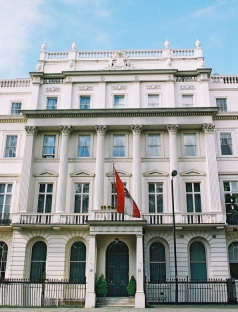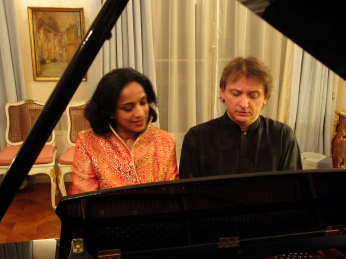‘Four
hands at one piano’:
Ranko Markovic and Marialena Fernandes perform Mozart
and Bruckner at the Austrian Embassy, 05. 11. 2006 (JPr)

The
concert was outstanding but the ambience in which it took
place added to the special feeling for this event. The
venue was the Austrian Embassy in Belgrave Square, a nineteenth-century
part of London that seems to be frozen in time compared
to the development and multi-culturalism of the rest of
London which one passes through travelling there.
A
quick look at the history of the Austrian Embassy in London
reveals that since the Congress of Vienna it has only
moved home once, and that was in 1866 when it went from
Chandos House, No.2 Queen Anne Street, to the present
building at 18 Belgrave Square. Apparently it remains
the only building of the Imperial and Royal Austro-Hungarian
Foreign Service still used today by Austrian diplomacy.
The
building was constructed between 1814 and 1825 by the
architect George Basevi according to a development plan
for Belgrave Square by Thomas Cubitt and Joseph Cundry.
The actual builder and first resident was philanthropist
William Haldimand. In 1866, it consisted of 74 living
rooms, salons, corridors, anterooms, servants’ pantries,
staircases and closets. After a period of renting, the
town house was finally bought in 1892 on behalf of Austria-Hungary.
A small wing was added to the building, consisting of
two administrative rooms, and another room above to be
used jointly by three diplomats. In 1911 the office wing
was further altered, providing space for the commercial
director, an office, an anteroom and two rooms for the
military and naval attachés.
Obviously
the use of the building mirrored European history of the
twentieth century and it seems so less important that
by 2006 has become the venue for a concert of Mozart and
Bruckner performed by the four hands of Ranko Markovic
and Marialena Fernandes who last year performed a four-hand
version of Mahler’s Sixth Symphony with much success in
London (See
review.)
Mozart,
who in his youth gave a great number of duet concerts
with his sister, became somewhat of a pioneer in composing
music for four hands. The Sonata in C major K521 (composed
1787) and played here with all the repeats, is very charming.
After an opening, fairly serious, fanfare there is a vivacious
Allegro with a number of various moods. The Andante
follows and seems to lead to what has been described as
an ardent duet between distraught lovers, and the recapitulation
brings some hints of sadness from that exchange. The
Allegretto is one of Mozart's musical jokes; it proceeds
calmly, or seems to, with the music trying to keep a straight
face despite some humorous interludes, including a false
ending involving scampering runs up and down the keyboard,
which then subside before the trick is repeated to end
the work.
During
the middle years of his life Bruckner struggled for recognition
of his music, particularly his symphonies, by the public
at large. Vienna was, in the 1870s and 1880s, in the throes
of an aesthetic controversy between the opposing schools
of Wagner and Liszt on one side siding against the more
‘conservative’ Eduard Hanslick (the influential nineteenth-century
music critic), with Johannes Brahms as undisputed figurehead.
The naive Bruckner became a pawn in a game of politics
he was intellectually unsuited for.
Bruckner
dedicated his Third Symphony, with musical quotations
from Die Walküre, to Richard Wagner. He made pilgrimages
to Bayreuth to attend the premières of Der Ring des
Nibelungen in 1876 and of Parsifal in 1882,
and subsequently joined the Wagner Society in Vienna.
This was interpreted by Hanslick and others as putting
Bruckner firmly in the Wagner camp which itself was indeed
only too pleased to have Bruckner as its ‘symphonist’.
This set Bruckner up against Brahms. In the aesthetic
cauldron of Vienna, conflicts were fought with unrestrained
vehemence and little tolerance and these undercurrents
prevented Bruckner’s works getting a fair hearing in the
Austrian capital. This is not altogether surprising since
the Gesellschaft der Musikfreunde (Society for
the Friends of Music) that determined what performances
would be put on in Vienna was firmly under the control
of Brahms and his associates. So Bruckner suffered the
scandalous neglect of the Viennese music establishment,
all the more so because, it was directed at someone ‘who,
unlike Wagner, was largely unable to defend himself.’
The first performance of Bruckner’s Third Symphony in
1877 was an unmitigated disaster, only a few people stayed
till the whole symphony was finished, and one off them
was Gustav Mahler.
Third
Symphony for piano duet is in a version (1877) was mostly
created by a young Gustav Mahler, though there is, as
the Bruckner scholar, Crawford Howie, mentioned in his
introduction to the concert, some debate about who exactly
did what. The idea is that Mahler transcribed the first
three movements and Bruckner’s pupil Rudolf Krzyzanowski
(who it must be assumed attended the disastrous 1877 performance)
the final one. It appears that the middle movements are
barely altered and are a genuine transcription whilst
last movement seems to foreshadow the later 1889 revision
of the Symphony. There may be more than a bit of Mahler
in the first movement but essentially this sounds like
Bruckner, though it loses a lot from being genuinely able
to recreate the brass, and not just in the famous trumpet
solo near the beginning that earned the composer the nickname
‘the trumpet’ from Richard Wagner. Despite what has been
done to it Bruckner’s vision comes shining through.

Markovic and Fernandes, who I am sure
are talented soloists in their own right are possibly
an even more impressive duo; they combine great technical
skill with complete unity of purpose, functioning as one
with a precise interplay of hands and rhythmic precision.
In the Mozart they clearly relished every comedic twist
and turn. They seemed to slyly comment on the music as
it unfolded letting us in on all the jokes, the intrigue
and the drama without giving the game away and spoiling
our fun too much.
The Bruckner was very interesting, convincing and potent.
An expressive opening began in mystery as it should do
and with the trumpet theme, a short descending phrase,
a cadence and a lyrical melody giving us all the musical
material for the first movement. The second movement mixed
piano fortissimos with moments of intimacy. The
Scherzo romped along, the trio took us into the Austrian
countryside and it all sounded quite spectacular. The
Finale had a whirling start, later involving a chorale
and a polka. Bruckner explained what this meant once to
a student of his when they passed a building where the
body of an eminent church architect lay in state. The
two could also hear dance music through the door of a
neighbouring inn. Bruckner explained, ‘In that house they're
dancing, but there the master lies in his coffin. That's
life, and that's what I wanted to show in my Third Symphony.
The polka represents the fun and joy of the world, and
the chorale represents its sadness and pain’. How Mahlerian
is that?
It
all came off outstandingly well though of course the end
of the symphony can never have the impact that the full
orchestra can give: nevertheless Markovic and Fernandes
gave it all they had got and it was mightily impressive.
There
was rapturous applause from the audience who were rewarded
once again with a sparkling example of Schoenberg’s four-hand
adaptation of Il barbieri di Siviglia as an encore.
This was very apt because The Society for Private Musical
Performances (Verein für musikalische Privataufführungen)
was founded by Arnold Schoenberg in 1918 in Vienna to
allow carefully rehearsed performances of ‘modern music’
accessible to those generally interested members of the
musical public willing to listen. In the three years between
February 1919 and 5 December 1921 (when the Verein
had to cease its activities) it gave 353 performances
of 154 works in a total of 117 concerts. It was very much
in this spirit that this full-house was at the Austrian
Embassy to hear this concert which as always (on these
occasions) was preceded by informative pre-concert talks
to put the music in context for the audience. There is
a rumour that the same four hands will perform Mahler’s
Seventh Symphony next year, and that is an event that
will be well worth attending.
Jim Pritchard




